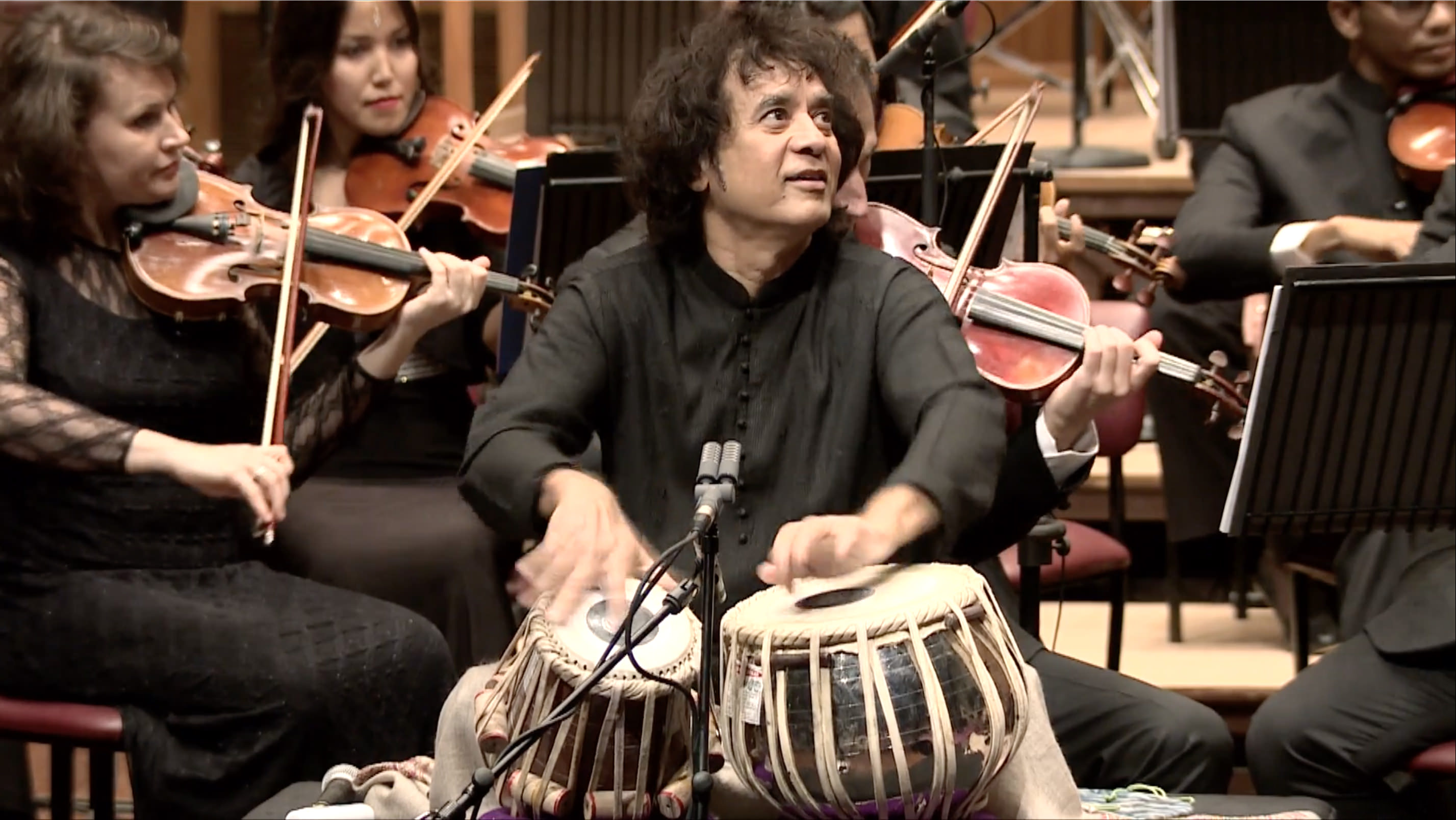
Last week at the Indian Film Festival of Los Angeles, legendary tabla maestro Ustad Zakir Hussain and conductor Zane Dalal floored the audience with eloquent insights into their life’s work and what it means to become a master of your craft. The talk followed a screening of the documentary “An Indian Accent”, directed by Sumantra Ghosal. The film documents a concerto for the tabla (played by Zakir Hussain) by the Symphony Orchestra of India (conducted by Zane Dalal).
Here are some excerpts from the conversation moderated by Dr. Vinod Venkataraman.
[VV to ZH] If art is how we decorate space, then music is how we decorate time. The movie “An Indian accent” shows the fluidity of your rhythm and absolute mastery over the instrument. Please explain how you have decorated space and time over the years, from being a student of music to a master in this art form.
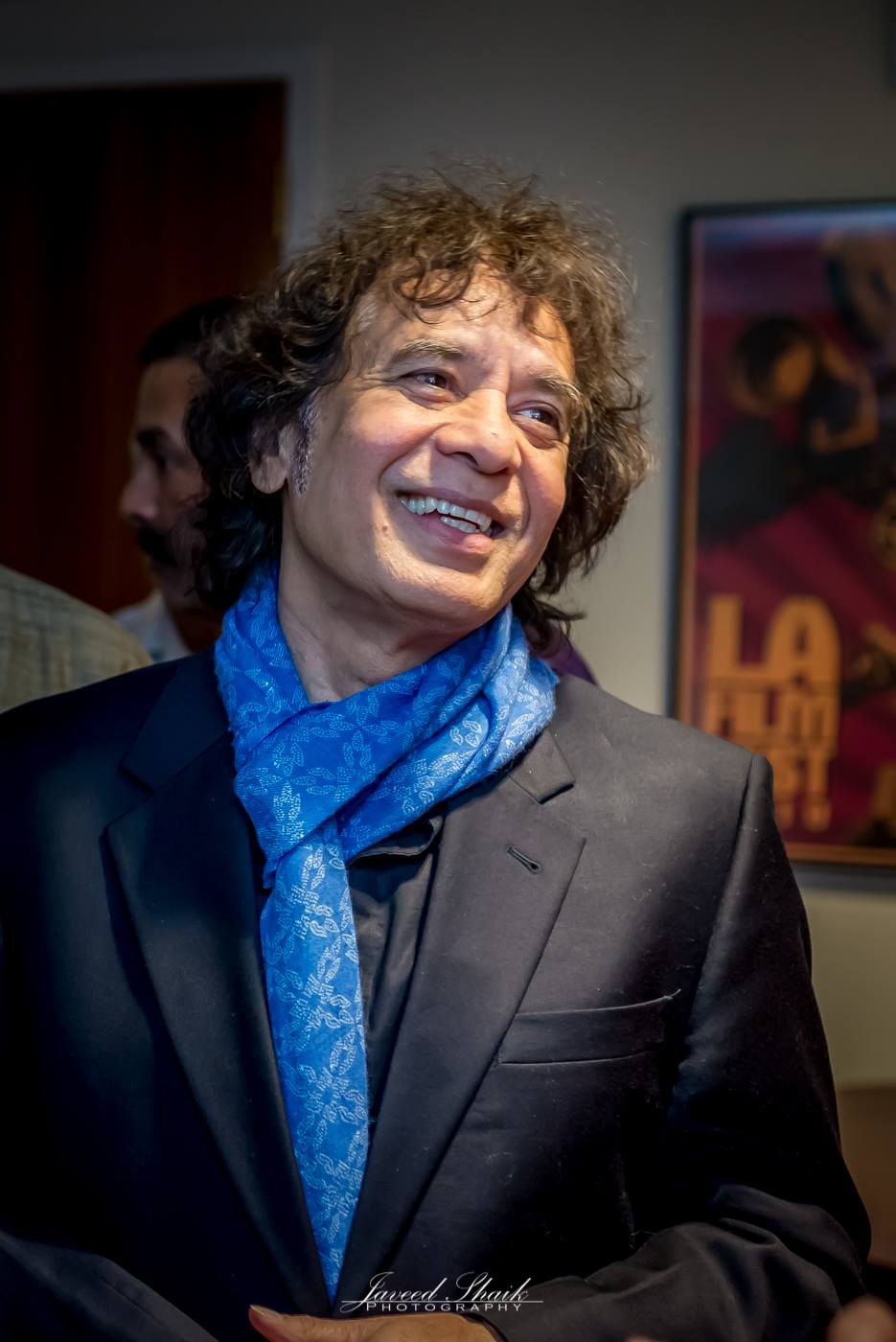
[ZH] Not a master. Just a student. I read somewhere that time is a plot to keep everything from happening at once. So you take one thing at a time. You don’t try to clutter up your table, which is your mind, with many different things. That’s why Indian music has been a good teacher. We deal with one note at a time, one beat at a time. The learning process over the last 45-50 years that I’ve been playing tabla, has been very interesting for me. I came home from the hospital as a 3-day old baby and had rhythms sung in my ear, by my father. So the training began but without me knowing about it. I was still a son and somewhere along the line, I moved up to the next step of being a student, then to being an apprentice, then an assistant, then a colleague and finally to being a friend of my father. It took so many decades of this process to be able to establish a friendship type of relationship with him. And that is exactly what it takes to be able to work with music and become comfortable in that zone. To become comfortable is to feel like it’s a cup of coffee you make every morning. If you turn it into a mountainous climb every day, if you turn it into an Everest trip every hour, the last thing you’d want to do is this. It’s a labor of love, it’s fun, it’s the greatest play pen, it’s the finest video game.
“To become comfortable is to feel like it’s a cup of coffee you make every morning. If you turn it into an Everest trip every hour, the last thing you’d want to do is this.” –Zakir Hussain
We in India believe that every instrument has a spirit. When you’re learning to play it, you must first humble yourself and have that instrument accept you. It’s like learning to ride a horse. You must first have the horse accept you as its rider, before you get to a relationship where the horse will bow down to you and say “Do with me as you will”. We saw that with very few instrumentalists – like Ustad Ali Akbar Khan, the great sarod player – his instrument bowed down to him and said “come in and I will be your friend through this journey and I will do your bidding”. So having that kind of a relationship with the music, with the teachers who you learn from, with the mentors who guide you and with the instrument that will give you the ride that you need to be able to reach that pinnacle, is what it’s all about. When I say reach the pinnacle, I actually err. There’s no reaching the pinnacle. There’s no getting to that final horizon because there’s no perfection. There will always be “This was as good as it could be today” and tomorrow it may look like you made a zillion mistakes that you didn’t see yesterday. It’s just a journey that you continue on and that instrument will take you on that journey.
“We in India believe that every instrument has a spirit. When you’re learning to play it, you must first humble yourself and have that instrument accept you. It’s like learning to ride a horse.” –Zakir Hussain
[VV to ZH] My Guruji once said about you – “If I was fast tonight, he was faster”. All of us admire the lighting fast physical reflexes of great gymnasts, boxers and other athletes. For those of us who have not been blessed with your gift, how do you explain the mental reflexes that you deploy with such awesome speed? Are you thinking faster than the rest of us?
[ZH] I’m just slowing down your thinking process!
It’s wrong for you to say that I’m so fast because I can name 18 different tabla players now who are faster than I am. I have to also say that I am not the best tabla player around. We tend to gravitate towards marquee names. When we thought about Indian music, we said “Oh! Pandit Ravi Shankar”. Nobody really bothered to think that there were 15 other equally great musicians in India. And we didn’t pay any attention to them. I have my name right up there and so people say “He’s the best”. No. I can tell you there are at least 15-20 tabla players who are just as good as I am, if not better on their day. This is a fact. I would tell you to google tabla and find them. Listen to them and really be impressed and you will see that their depth is amazing. The difference that I have and I’ve to credit my master with this, is that when I was learning – the rhythms were being sung in my ear from day 3.
“I am not the best tabla player around. We tend to gravitate towards marquee names. When we thought about Indian music, we said “Oh! Pandit Ravi Shankar”. Nobody really bothered to think that there were 15 other equally great musicians in India.” –Zakir Hussain
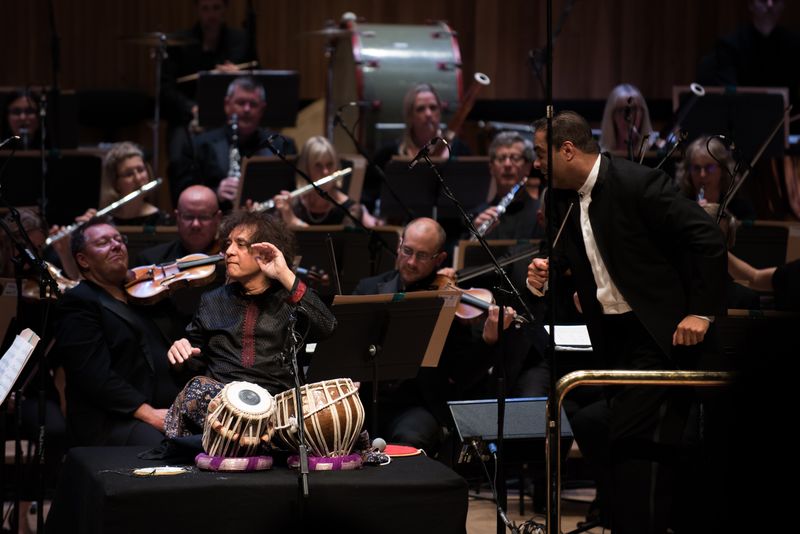
When I was seven years old, my father asked me “Do you really want to study this?” He had waited till then. I said “Of course, that’s what I want to do. Didn’t you know?” And he said “Of course. So we start tomorrow”. And tomorrow meant at 3 o’clock in the morning. I was woken up and my training began in earnest. And the training was not sitting with the instrument, but just sitting with him one-on-one in the balcony and just talking rhythms. He would tell me rhythms, he would ask me to sing it back, he would tell me where they came from, the lineage behind the compositions, the great masters, the salient features. And all the time, I had to sing it back. So that was one thing and the other thing he said was “Keep your arriving point firmly placed in your view”. Now when you’re flying an airplane, you keep the horizon very balanced on a little meter that you have. You must make sure that the plane is balanced and know where you’re going. So he said “Sam ko dekho”. It means “Look at the down beat.” That’s your beacon, that’s where you need to arrive. I had all this information in my head and it became so much easier. My hands got fast but at the same time, my mind had learned how to walk the path, how to arrive at the destination. So if I could do it mentally, I could quickly transpose and send that information from my brain straight to my hand.
“To read the Quran and then go to the church was normal. To recite the Ganesh Vandana and then go and read the Quran was ok. None of the keepers of those traditions ever pressed the idea in my head that they were all very different from each other. They weren’t. They were all the same.” –Zakir Hussain
That was the training for those first 3 or 4 years, when we sat every night in the balcony, until at 6 o’clock my mother would snatch me away from him, shove some breakfast in my mouth, get me ready and send me off to the madrasa. There, I would read the Quran. Now between 3 and 6 a.m., I was told all the stories about Lord Ganesh, Lord Shiva, Saraswati, the Ganesh Vandana on the tabla or the Shiva Stuti. Then I’d go to the madrasa and read the Quran. And after an hour or so of doing that, I would cross the street and assemble with my fellow students in St. Michael’s church. We’d do that until we’d march to our classrooms and then we’d learn our history, geography and mathematics. So within that space of time, I would go through a whole gamut of so many different ways of life. But what was interesting about it was that none of the keepers of those traditions ever pressed the idea in my head that they were all very different from each other. They weren’t. They were all the same. So I grew up with the idea that all of this was normal. To read the Quran and then go to the church was normal. To recite “Gananam Ganpati Ganesh Lambodar Sohey…” and then go and read the Quran was ok. And none of those guys said “No you can’t do it. You can’t do that because you’re doing this”. It was normal. That’s also exactly the idea that my father instilled in me – the idea that all this was normal. Like I said earlier, I wasn’t climbing Mt. Everest. It was an everyday thing to do. So not having that great responsibility that “Oh, I am doing something which is 2000 years old” and so on, allowed me to be able to freely translate things from one mode to another. To transpose without hesitation and to develop that instant reaction, to go from one to the other real-time – that’s probably what it is that you’re seeing.
[VV to ZD] I’m sure this is a question on everyone’s mind after watching the film. In the Symphony Orchestra of India, we saw only one Indian face!
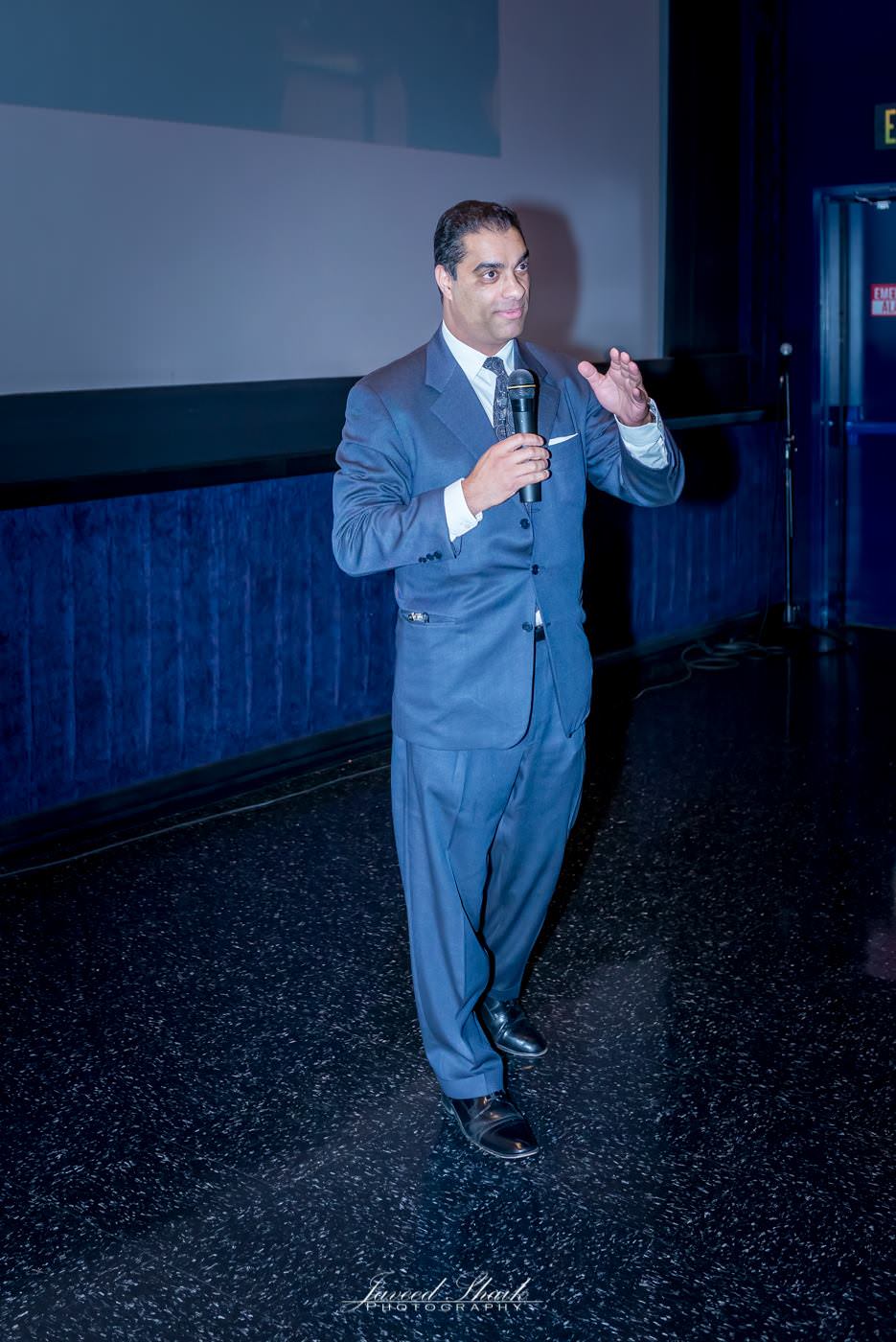
[ZD] We decided that it was time that a global metropolis like Mumbai, if it was going to be a global center and attract Western investment, had an orchestra. The cultural moment in any city is its orchestra. Mumbai never had a symphony orchestra but there’s an audience for it, which we’re building. Now, the western orchestra is not a national pastime. It is not, for lack of a better word, a brown face photo-op. You have to play properly. Otherwise we would have to step back on the world stage and say “this is the symphony orchestra of India” and people would say “Oh they’re quite good for India.” No no no. We need people to say “They’re good!” And not every orchestra is a national orchestra. There are more Russian Israelis in the New York philharmonic and more Japanese musicians in the Berlin philharmonic. It’s not like having a national soccer team. They’re not raising flags at the UN. They’re involved in an art form.
“There are more Russian Israelis in the New York philharmonic and more Japanese musicians in the Berlin philharmonic. It’s not like having a national soccer team. They’re involved in an art form.” –Zane Dalal
We actually have 14 Indian musicians, which given the fact that there are no conservatories in India that would allow advanced students to come to that level, is a mind blowing miracle in itself. We shouldn’t be crying over spilt milk and saying “we’ll always have a white orchestra”. The schools weren’t there, so we started our own. We now have an academy of very young children and they’re playing absolutely fantastically. There’s a wonderful Indian family with three daughters and they’re a trio. One plays the piano, the second plays cello and the third plays the violin – all with perfect form and they’re 7, 9 and 12. So this is a long term process. If we decided to have only Indian musicians in the orchestra, we wouldn’t be here today.
[VV to ZD] Musical collaboration is like a conversation. You were in a unique position of not being directly connected with an instrument in your hand. Your instrument was the baton. You had to communicate through the co-ordination of 60-70 musicians thinking, breathing and feeling the music. Can you tell us a bit about that process and how you did it effectively?
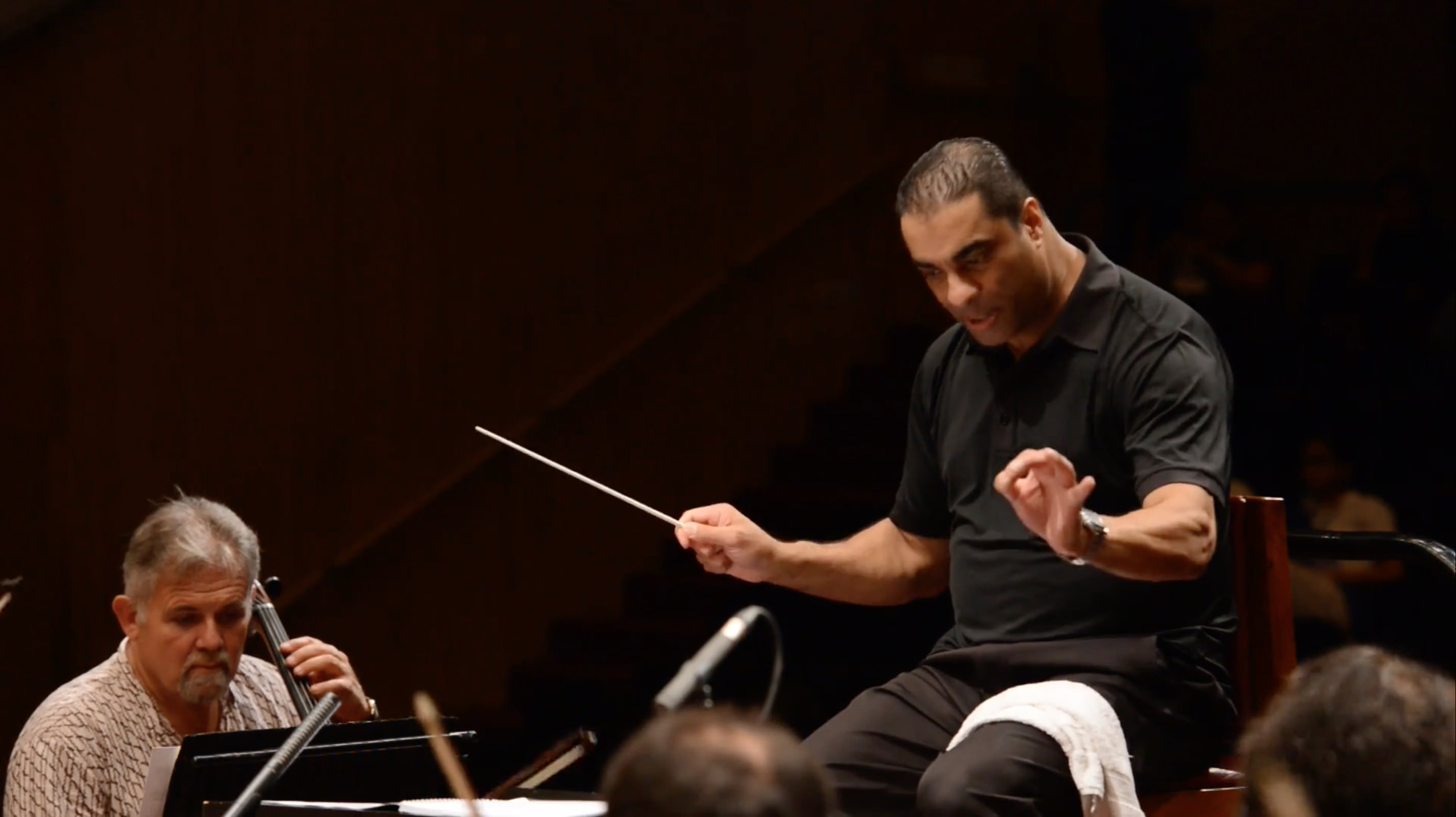
[ZD] You’re asking me what conductors do! I’ll try and encapsulate it. About your question on the collaboration – yes, it is a grand collaboration. If I use those two words again, in the sense of everybody’s lives on the whole planet, it is a grand collaboration. When the conductor is up there, he is on a box so that the people in the back can see him clearly. That’s it. If you want to know what the police work is and why the stick is there – it never used to be. I can give you a short history of conducting – people never used to have conductors. They used to have very competent musicians playing the piano, playing the violin and leading the rest of the group. The first conductor on the job was Jean Baptiste Lully. He was in the French school and in those days you had a big stick that you banged on the ground to beat time. And he banged into his right foot, got gangrene and died. He literally died from the job. I don’t think a conductor has done that since. So from that moment on, the stick got shorter and got placed in the hand.
“If there was ever any guidance from the conductor, it must be upward, never downward.” –Zane Dalal
Here’s what conducting actually is. We must anticipate. You see 70 musicians in front of you – they are reading music, they are intensely involved in creating the sound. I don’t create any sound. My instrument, if you like, is the orchestra. When they choose to look at you, they must know where they were, where they are and where they will be. In the one moment that each individual chooses to check through peripheral vision, with where you are, you have to be that clear and that open to what’s coming back. So as maestro Hussain said, we paint in sound. And this canvas is a complete collaboration of listening and working with each other. It’s very elastic. And my police work is to make sure that this sort of amazing wall, this organic wall of sound is kept afloat and has a life of its own. And if I’ve done my job properly, then I haven’t disturbed it. That’s really the key to it. I’m not stuck in there telling people what to do. That’s wrong. There’s no oppression. If there was ever any guidance from the conductor, it must be upward, never downward.
Ustad Zakir Hussain was awarded the Padma Shri in 1988, the Padma Bhushan in 2002 and the Sangeet Natak Akademi Award in 1990. In 1999, he was awarded the United States National Endowment for the Arts’s National Heritage Fellowship. The album Global Drum Project (Mickey Hart, Zakir Hussain, Sikiru Adepoju, and Giovanni Hidalgo) won the Grammy Award for Best Contemporary World Music Album at the 51st Grammy Awards in 2009. Hussain has made many contributions to world music with historic collaborations, and recorded and performed with artists as diverse as George Harrison, YoYo Ma, Joe Henderson, Van Morrison, Airto Moreira, Pharoah Sanders, Billy Cobham, Mark Morris, Rennie Harris, and the Kodo drummers.
Zane Dalal led the Symphony Orchestra of India on their first tour to Europe, performing in the cities of Zurich, Geneva and St. Gallen. The European premiere of Zakir Hussain’s tabla concerto – Peshkar, – commissioned especially for this tour and world premiered in Mumbai in September 2015 – was given in Zurich, on 19th January, 2016 with the composer as soloist.















